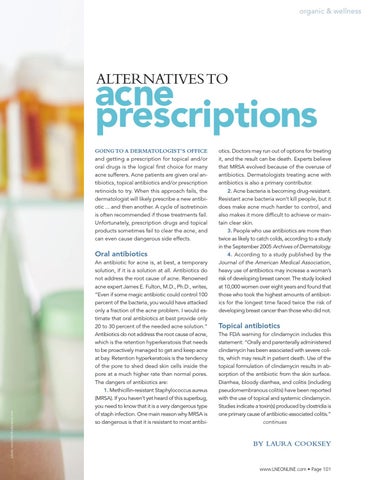organic & wellness
acne prescriptions ALTERNATIVES TO
GOING TO A DERMATOLOGIST’S OFFICE and getting a prescription for topical and/or oral drugs is the logical first choice for many acne sufferers. Acne patients are given oral antibiotics, topical antibiotics and/or prescription retinoids to try. When this approach fails, the dermatologist will likely prescribe a new antibiotic ... and then another. A cycle of isotretinoin is often recommended if those treatments fail. Unfortunately, prescription drugs and topical products sometimes fail to clear the acne, and can even cause dangerous side effects.
Oral antibiotics
photo: micro10x/Shutterstock.com
An antibiotic for acne is, at best, a temporary solution, if it is a solution at all. Antibiotics do not address the root cause of acne. Renowned acne expert James E. Fulton, M.D., Ph.D., writes, “Even if some magic antibiotic could control 100 percent of the bacteria, you would have attacked only a fraction of the acne problem. I would estimate that oral antibiotics at best provide only 20 to 30 percent of the needed acne solution.” Antibiotics do not address the root cause of acne, which is the retention hyperkeratosis that needs to be proactively managed to get and keep acne at bay. Retention hyperkeratosis is the tendency of the pore to shed dead skin cells inside the pore at a much higher rate than normal pores. The dangers of antibiotics are: 1. Methicillin-resistant Staphylococcus aureus (MRSA). If you haven’t yet heard of this superbug, you need to know that it is a very dangerous type of staph infection. One main reason why MRSA is so dangerous is that it is resistant to most antibi-
otics. Doctors may run out of options for treating it, and the result can be death. Experts believe that MRSA evolved because of the overuse of antibiotics. Dermatologists treating acne with antibiotics is also a primary contributor. 2. Acne bacteria is becoming drug-resistant. Resistant acne bacteria won’t kill people, but it does make acne much harder to control, and also makes it more difficult to achieve or maintain clear skin. 3. People who use antibiotics are more than twice as likely to catch colds, according to a study in the September 2005 Archives of Dermatology. 4. According to a study published by the Journal of the American Medical Association, heavy use of antibiotics may increase a woman’s risk of developing breast cancer. The study looked at 10,000 women over eight years and found that those who took the highest amounts of antibiotics for the longest time faced twice the risk of developing breast cancer than those who did not.
Topical antibiotics The FDA warning for clindamycin includes this statement: “Orally and parenterally administered clindamycin has been associated with severe colitis, which may result in patient death. Use of the topical formulation of clindamycin results in absorption of the antibiotic from the skin surface. Diarrhea, bloody diarrhea, and colitis (including pseudomembranous colitis) have been reported with the use of topical and systemic clindamycin. Studies indicate a toxin(s) produced by clostridia is one primary cause of antibiotic-associated colitis.“ continues
BY LAURA COOKSEY
www.LNEONLINE.com • Page 101
